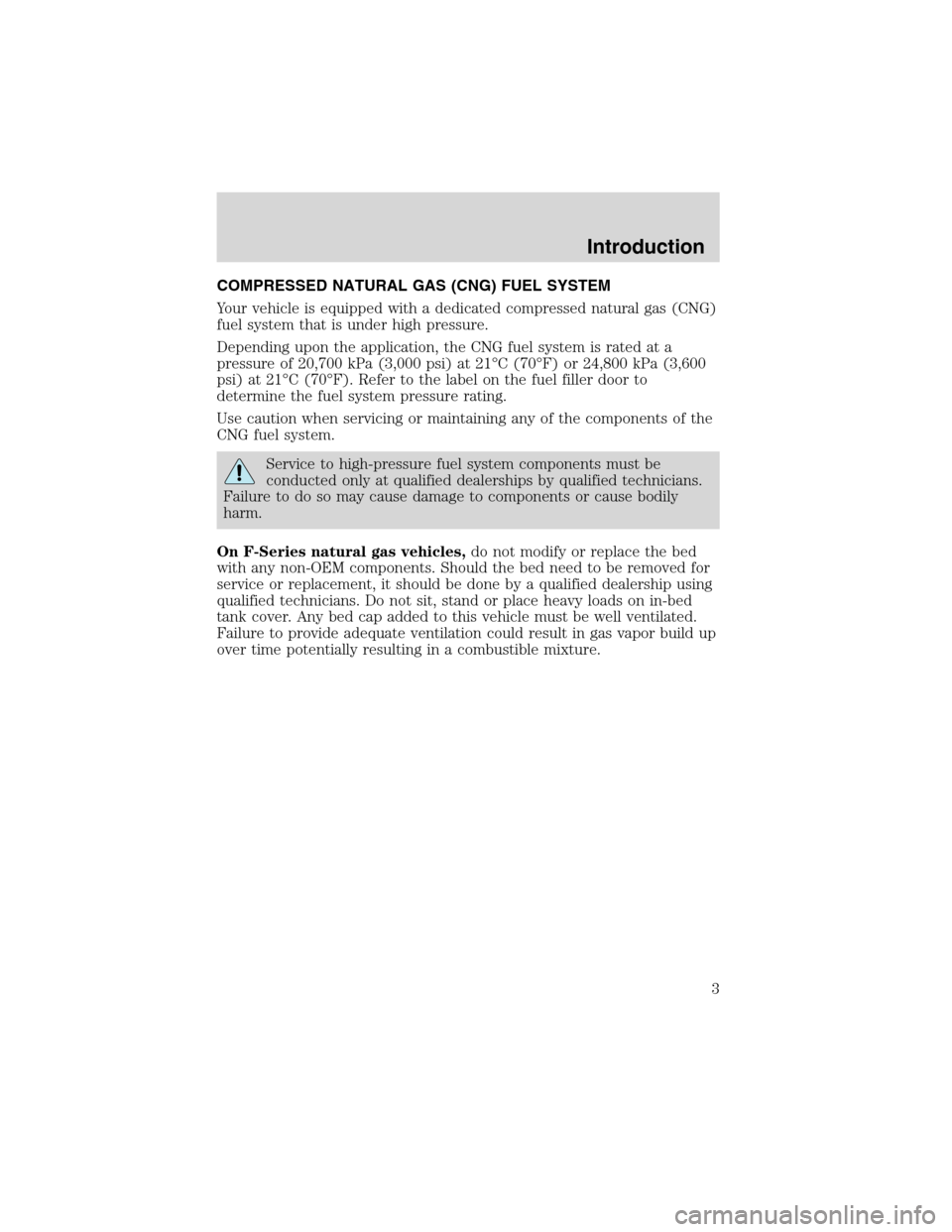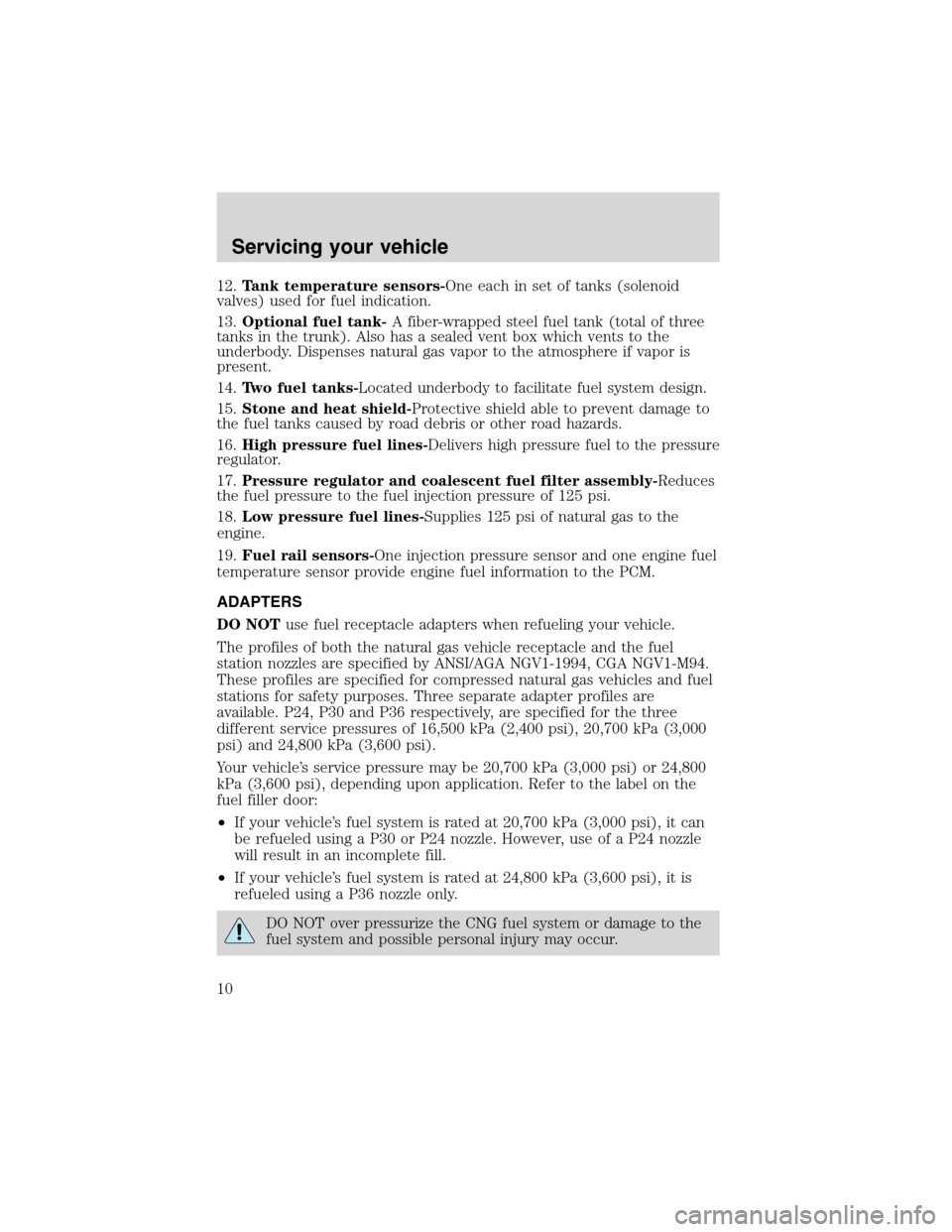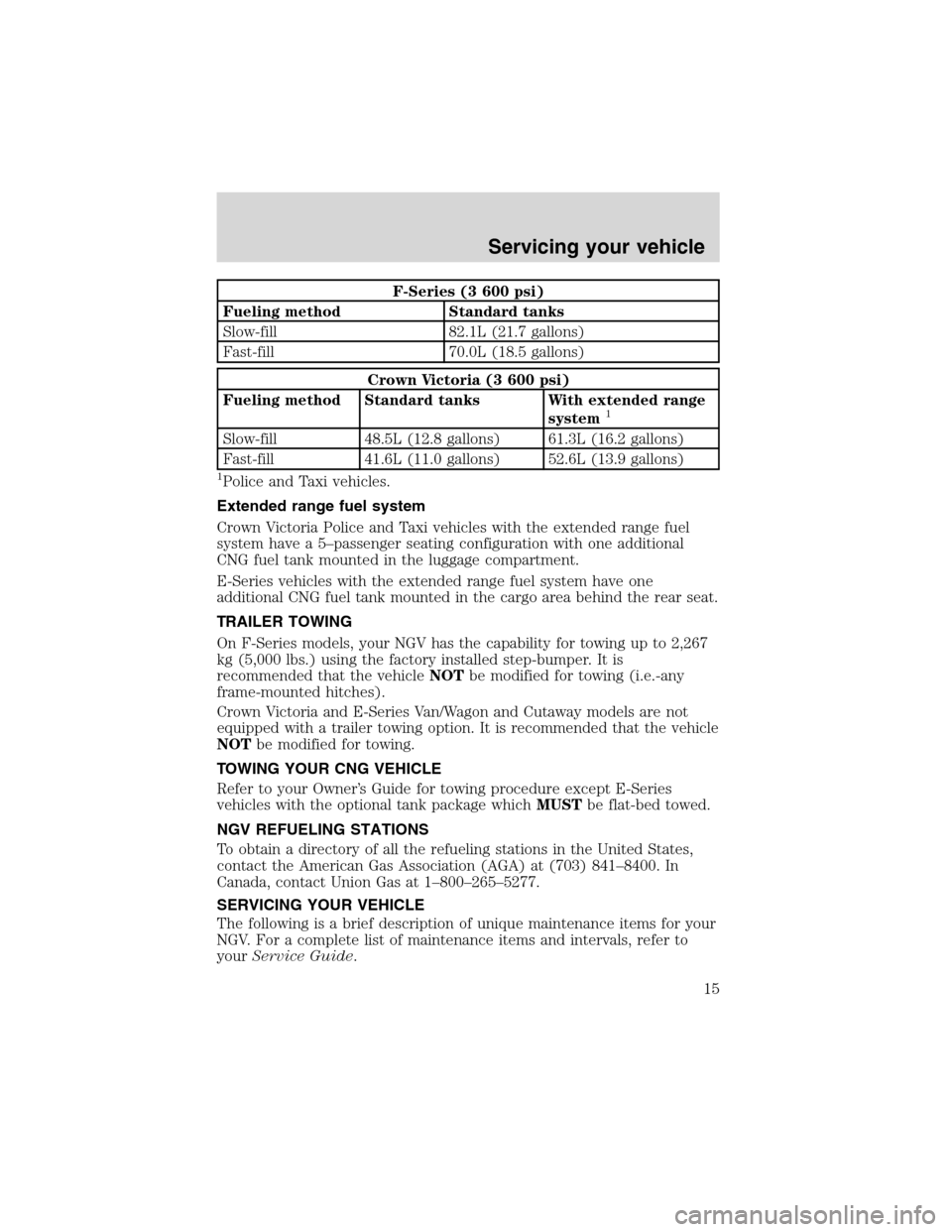service FORD E SERIES 2003 4.G Natural Gas Vehicle Supplement Manual
[x] Cancel search | Manufacturer: FORD, Model Year: 2003, Model line: E SERIES, Model: FORD E SERIES 2003 4.GPages: 16, PDF Size: 0.08 MB
Page 2 of 16

ABOUT THIS SUPPLEMENT
This booklet supplements your Owner Guide and is part of the owner’s
portfolio. It describes the operation of your natural gas vehicle (NGV)
and how it differs from a standard gasoline powered vehicle. Therefore it
is very important that you read this guide and thoroughly familiarize
yourself and others operating the vehicle with this information.
Some of the information in this supplement replaces certain instructions
in the Owner Guide. Please read this supplement carefully and
completely. Refer to the Owner Guide for complete vehicle information.
WARNINGS
Warnings remind you to be especially careful in those areas of the
vehicle where carelessness can cause damage to your vehicle or possible
personal injury to yourself, your passengers or others. Please read all
warnings carefully.
ABOUT THE WARRANTIES
The normal vehicle warranties will apply to your NGV. For further
information, refer to your Warranty Information Booklet.
Specified maintenance procedures must be followed. Repairs must be
made by trained personnel.
It is important that your NGV be properly maintained by qualified Ford
trained gaseous fuel service technicians. If a problem occurs, it is
important that properly trained personnel diagnose and repair the cause.
If the problem relates to the fuel system, proper part replacement is
imperative to keep your vehicle operating correctly. NGV fuel system
components and standard gasoline fuel system components are not
interchangeable. If your NGV is not maintained in accordance with
approved service procedures, damage may occur and your warranty may
be invalidated.
Any modification to the fuel system of your NGV voids the Ford New
Vehicle Limited Warranty.
Introduction
2
Page 3 of 16

COMPRESSED NATURAL GAS (CNG) FUEL SYSTEM
Your vehicle is equipped with a dedicated compressed natural gas (CNG)
fuel system that is under high pressure.
Depending upon the application, the CNG fuel system is rated at a
pressure of 20,700 kPa (3,000 psi) at 21°C (70°F) or 24,800 kPa (3,600
psi)at21°C (70°F). Refer to the label on the fuel filler door to
determine the fuel system pressure rating.
Use caution when servicing or maintaining any of the components of the
CNG fuel system.
Service to high-pressure fuel system components must be
conducted only at qualified dealerships by qualified technicians.
Failure to do so may cause damage to components or cause bodily
harm.
On F-Series natural gas vehicles,do not modify or replace the bed
with any non-OEM components. Should the bed need to be removed for
service or replacement, it should be done by a qualified dealership using
qualified technicians. Do not sit, stand or place heavy loads on in-bed
tank cover. Any bed cap added to this vehicle must be well ventilated.
Failure to provide adequate ventilation could result in gas vapor build up
over time potentially resulting in a combustible mixture.
Introduction
3
Page 10 of 16

12.Tank temperature sensors-One each in set of tanks (solenoid
valves) used for fuel indication.
13.Optional fuel tank-A fiber-wrapped steel fuel tank (total of three
tanks in the trunk). Also has a sealed vent box which vents to the
underbody. Dispenses natural gas vapor to the atmosphere if vapor is
present.
14.Two fuel tanks-Located underbody to facilitate fuel system design.
15.Stone and heat shield-Protective shield able to prevent damage to
the fuel tanks caused by road debris or other road hazards.
16.High pressure fuel lines-Delivers high pressure fuel to the pressure
regulator.
17.Pressure regulator and coalescent fuel filter assembly-Reduces
the fuel pressure to the fuel injection pressure of 125 psi.
18.Low pressure fuel lines-Supplies 125 psi of natural gas to the
engine.
19.Fuel rail sensors-One injection pressure sensor and one engine fuel
temperature sensor provide engine fuel information to the PCM.
ADAPTERS
DO NOTuse fuel receptacle adapters when refueling your vehicle.
The profiles of both the natural gas vehicle receptacle and the fuel
station nozzles are specified by ANSI/AGA NGV1-1994, CGA NGV1-M94.
These profiles are specified for compressed natural gas vehicles and fuel
stations for safety purposes. Three separate adapter profiles are
available. P24, P30 and P36 respectively, are specified for the three
different service pressures of 16,500 kPa (2,400 psi), 20,700 kPa (3,000
psi) and 24,800 kPa (3,600 psi).
Your vehicle’s service pressure may be 20,700 kPa (3,000 psi) or 24,800
kPa (3,600 psi), depending upon application. Refer to the label on the
fuel filler door:
•If your vehicle’s fuel system is rated at 20,700 kPa (3,000 psi), it can
be refueled using a P30 or P24 nozzle. However, use of a P24 nozzle
will result in an incomplete fill.
•If your vehicle’s fuel system is rated at 24,800 kPa (3,600 psi), it is
refueled using a P36 nozzle only.
DO NOT over pressurize the CNG fuel system or damage to the
fuel system and possible personal injury may occur.
Servicing your vehicle
10
Page 11 of 16

NATURAL GAS DISPENSING
Most dispensers have a digital indicator displaying the cost and amount
of fuel delivered to your vehicle. Fuel delivery to the vehicle is stopped
when the pressure of fuel stored on the vehicle equalizes with the
temperature compensated pressure of fuel stored at the station. As the
pressure between the station and vehicle equalizes, the cost and quantity
meters slow to a near stop. When this occurs, refueling is complete.
Certain noises can be expected during the refueling process and may
vary depending on the type of fuel station and your proximity to the fuel
compression and storage equipment. At the beginning of refueling you
might hear the rushing noise of gas entering the vehicle through the
station hose and tubing. At the end of refueling, the fuel receptacle on
the vehicle may make a high pitch noise or chatter. This is another
indication that refueling is nearly complete. Also, the station compression
equipment may turn on at any time during the refueling process.
FUEL QUALITY
Use only a CNG fuel that meets the specification of NFPA-52 and SAE
J1616 in your NGV. Specifications NFPA-52 and SAE J1616 place limits
on particulate contamination and moisture content to ensure a quality
CNG fuel.
The use of a CNG fuel that does not meet specifications NFPA-52 and
SAE J1616 isnot recommendedand may cause engine damage.
Use of poor quality CNG fuel may result in:
•component failure.
•leakage from the fueling point.
•poor vehicle operation.
Use of poor quality fuel may also result in your warranty being
invalidated.
SERVICING YOUR NATURAL GAS VEHICLE
Service to the CNG fuel system should be conducted at a
qualified dealership by a trained NGV technician only. Failure to
do so may cause damage to components or cause bodily harm.
Servicing your vehicle
11
Page 15 of 16

F-Series (3 600 psi)
Fueling method Standard tanks
Slow-fill 82.1L (21.7 gallons)
Fast-fill 70.0L (18.5 gallons)
Crown Victoria (3 600 psi)
Fueling method Standard tanks With extended range
system
1
Slow-fill 48.5L (12.8 gallons) 61.3L (16.2 gallons)
Fast-fill 41.6L (11.0 gallons) 52.6L (13.9 gallons)
1Police and Taxi vehicles.
Extended range fuel system
Crown Victoria Police and Taxi vehicles with the extended range fuel
system have a 5–passenger seating configuration with one additional
CNG fuel tank mounted in the luggage compartment.
E-Series vehicles with the extended range fuel system have one
additional CNG fuel tank mounted in the cargo area behind the rear seat.
TRAILER TOWING
On F-Series models, your NGV has the capability for towing up to 2,267
kg (5,000 lbs.) using the factory installed step-bumper. It is
recommended that the vehicleNOTbe modified for towing (i.e.-any
frame-mounted hitches).
Crown Victoria and E-Series Van/Wagon and Cutaway models are not
equipped with a trailer towing option. It is recommended that the vehicle
NOTbe modified for towing.
TOWING YOUR CNG VEHICLE
Refer to your Owner’s Guide for towing procedure except E-Series
vehicles with the optional tank package whichMUSTbe flat-bed towed.
NGV REFUELING STATIONS
To obtain a directory of all the refueling stations in the United States,
contact the American Gas Association (AGA) at (703) 841–8400. In
Canada, contact Union Gas at 1–800–265–5277.
SERVICING YOUR VEHICLE
The following is a brief description of unique maintenance items for your
NGV. For a complete list of maintenance items and intervals, refer to
yourService Guide.
Servicing your vehicle
15
Page 16 of 16

Tank inspection and replacement
For your protection, the CNG fuel tanks require visual inspection every
three years or 58,000 kilometers (36,000 miles) whichever comes first.
The purpose of the inspection is to check for exterior damage to the
tank which would shorten its usable life span. This inspection should
only be done by qualified NGV Ford service technicians.
The expiration date for the tank replacement is stated on each tank label
See instructions on fuel container for inspection and service life.
Coalescent fuel filter assembly
Your vehicle is equipped with a coalescent fuel filter assembly. Its
primary function is to remove contaminants; oil and water carryover
moisture from the fuel and trap it in the filter bowl.
The coalescent filter bowl should be drained every 48,000 kilometers
(30,000 miles). Perform fuel system depressurization procedure (outlined
in Service Manual) before disassembling the filter to avoid fuel pressure
regulator damage. The filter element (FG-985 on E-Series and F-Series
models; FG-976 on Crown Victoria models) and housing O-ring seal
should also be replaced every 48,000 km (30,000 miles).
Inspect and clean fuel fill valve filter
On Crown Victoria and F-Series models, the fuel fill valve filter is
located in the high-pressure fuel line. Inspection and cleaning
should only be done by a qualified technician.
The fuel fill valve filter should be inspected and cleaned annually. Fuel
fill valve filter replacement is only required when damage to the filter is
visible.
Spark plugs
Replace spark plugs every 96,000 kilometers (60,000 miles) on E-Series
and F-series models and every 60,000 km (36,000 miles) on Crown
Victoria models. Use recommended nickel-plated platinum spark plugs
with the Motorcraft part number AWSF-22FM1 (or equivalent) on
E-Series and F-series models and spark plugs with the Motorcraft part
number AWSF-22FM (or equivalent) on Crown Victoria models.
Servicing your vehicle
16